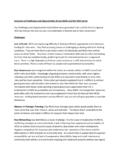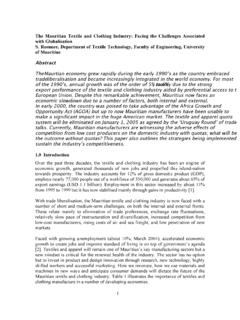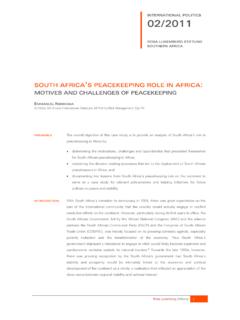Transcription of Challenges facing the Lebanese SME Sector - …
1 5/16/2013 1 Challenges facing the Lebanese SME Sector Zeina El Khoury Head of Enterprise Team Ministry of Economy and Trade What is an SME? There is no universal definition of SME; different countries follow different criteria, but all agree that they are enterprises with considerable growth potential 5/16/2013 2 Definition of SMEs Lebanon European Union Egypt South Korea Singapore Micro Small Medium ? 10 employees 2 M Turnover or 2 M Balance Sheet 50 employees 10 M Turnover or 10 M Balance Sheet 250 employees 50 M Turnover or 43 M Balance Sheet 20 employees 100 employees 500 employees 5 employees 15 employees 50 employees Service SME Manufacturing SME 200 employees 300 employees SME 300 employees <100 M Turnover ? ? Unites States 5/16/2013 3 Increase Growth Decrease Poverty Generate employment Increase output with value added Increase household income Increase firms and national competitiveness and productivity Spur innovation Increase exports Generate fiscal revenues Create competition Nurture entrepreneurship culture including that of women and youth I II III IV V VI VII VIII IX SMEs contribute substantially to their economies and play a central role in enhancing economic dynamism, job creation and innovation SMEs Contribution to Economies 5/16/2013 4 UNESCSAP, OECD, SBA country factsheets.
2 CAS 1996 25% 38% 42% 51% 52% 54% 56% 59% 61% 70% 75% 79% 79% 88% KSAE gyptUAEL ebanonSingaporeUKUSAM alaysiaFranceJapanChinaSpainGermanyKorea 68% Developed Countries SMEs share of Total Workforce SMEs share of Exports 6% 16% 19% 22% 39% 42% 46% 56% 69% 69% JapanSingaporeMalaysiaUSAK oreaFranceUKGermanySpainChina37% Developed Countries SMEs contribution to GDP 25% 30% 32% 33% 40% 50% 51% 52% 53% 54% 57% 58% 64% KSAUAEM alaysiaEgyptSingaporeKoreaUKUSAG ermanyFranceJapanChinaSpain53% Developed Countries Worldwide, they represent more than 95% of enterprises, employ around 68% of developed countries working population, their share of exports amounts to 37% , and they contribute to 53% to their GDP on average SMEs Contribution to Employment, Exports and GDP 5/16/2013 5 Funding support a range of grants, loans, credit guarantees and co-investments Export assistance - local market information Support companies to become leaner Incentives to stimulate in-company R&D Assistance with R&D collaboration Training and mentorship Connections and introductions to customers overseas All their advisory services are Sector specific Innovation support and funding, favoring technology transfer and innovative projects with genuine market potential Guarantees for bank loans and equity contributions Financing for investments and working capital requirements Advisory services and customized advised to SMEs to enhance productivity Support innovation through five research and polytechnics centers.
3 And through innovation voucher Training for SMEs on leadership, branding, customer service, design, IP management and marketing Service Excellence Programs Grants relating to consultancy, training, and certification Funding, loans and credit guarantee schemes Ireland France Singapore Turkey Interest subsidized loan for export activities, working capital, employment Financial support for domestic fairs, consultancy, training, energy efficiency, industrial property rights and business trips abroad and R&D Loans for Industrial Implementation Support Program Applied Entrepreneurship Training Program Supports financially and technically SMEs by getting them into capital market Given their importance and potential, most countries have included SME development in their growth strategies, thus shaped large scale support mechanisms and created agencies to develop this Sector SME Institutionalization 45% of the Lebanese population are young Lebanon will need to create 23,000 jobs per year, 6 times more, to absorb the new entrants to the Labor market* Unemployment is 11%, 35% among the youth (1 out of 3) High rate of youth and skilled emigration Brain drain losses are huge and outweigh the benefits, mainly remittances Lebanon ranks 120 out of 144 countries in the world in brain drain losses, according to the Global Competitiveness Index 5/16/2013 6 Good Jobs Needed.
4 The Role of Macro, Investment, Education, Labor, and Social Protection Policies , World Bank, Dec 2012 Unemployment Economic Slowdown in 2012 and forecasts around 2% in 2013, well below Lebanon s potential Loss in National Competitiveness Increasing operational and production costs Depleting Infrastructure Substantial Brain Drain 3 2 4 1 Supporting this Sector is key to help Lebanon overcome its Challenges , most importantly, JOB CREATION Pressing Challenges facing Lebanon 5/16/2013 7 Take stock of already existing initiatives Assess Lebanon s standing in Business Environment indicators Define drivers for SME development Assess drivers and identify Challenges Transform Challenges into prospect initiatives Consult with stakeholders and secure buy in Assign owners for initiatives Agree on timelines and implementation plans Assessment of the Current State Policy and Initiative Formulation Implementation Monitoring and Evaluation 1 2 3 4 Focus of this presentation Implement initiatives as per agreed-upon action plans and timelines Track and report progress of initiatives Identify potential improvement opportunities Adjust implementation accordingly Despite the existence of several
5 Scattered policies and initiatives to support SMEs, they still face Challenges . To overcome those, a COMPREHENSIVE SUPPORT STRATEGY needs to be formulated SME Strategy Formulation and Implementation 5/16/2013 8 Ease of Doing Business International Finance Corporation Index of Economic Freedom Heritage Foundation 91 115 90 112 89 89 Dealing with construction permits Resolving insolvency Enforcing contracts Top 3 Constraints/Problematic Factors Property rights Freedom from corruption Business freedom Global Competitiveness Indicator, World Economic Forum N/A 91 89 Inadequate supply of infrastructure Inefficient government bureaucracy Government Instability 92 Enterprise Survey World Bank Political stability Electricity Access to finance Not Applicable Not Comparable 2013 2012 2011 2010 To start with.
6 A review of Lebanon s standing in key business environment and competitiveness indicators was conducted - highlighting a backsliding performance Business Environment Snapshot: Key Competitiveness Indicators 5/16/2013 9 Business Environment Drivers Firm Competitiveness Drivers Core Driver Policy Efficiency Drivers Furthermore, a detailed assessment of the SME Sector was undertaken based on the key drivers of SME development and startup creation Framework for SME Development Regular and Consistent Data and Research Entrepreneurship Support Programs and Institutions Political Stability Infrastructure Macroeconomic Environment Regulatory Framework and Enforcement Institutional Structure Statistics and Research 5/16/2013 10 Challenges SME share of total loans amounted to 16% in 2010, significantly lower than 26% in developed countries High levels of collateral needed Very limited venture capital deals, equity and angel investments.
7 One reason is the lack of exit strategies for these investments due to Weak capital markets Lack of an efficient insolvency framework for businesses and bankruptcy law Family owned nature of SMEs is reluctant to equity investments ( of firms interviewed by MoET in 2007 found equity financing unattractive) Low microfinance penetration, with a large market gap estimated by IFC in 2008 to be around 88% Substantial number of informal firms Limited access to finance for women entrepreneurs, 51% of female business owner sought loans but only 17% were granted. (IFC survey 2011) Key Illustration 65 86 90 126 128 128 129 133 144 161 171 210 243 MalaysiaEgypt, Arab , , of collateral needed for a loan (% of the loan) 124 Eastern Europe& Central AsiaHigh-incomeOECDL atin America& CaribbeanLebanonMiddle East &North Africa Proportion of investments financed by equity or stock sales World Bank Enterprise Survey, 2009 Access to finance is considered to be one of the top constraints SME development.
8 In spite of the significant improvements in the last decade Access to Finance Firm Competitiveness Drivers 5/16/2013 11 Challenges Persistent gap or mismatch between the skills acquired at university and the requirements of business Relatively under-developed Vocational Education systems and no link between businesses and vocational education No forward looking vision or sectoral studies to help determine the future market needs and the labor demand to align with university policies and degrees Low levels of employee training on the job Key Illustration Percent of firms identifying an Inadequately Educated Workforce as a major constraint World Bank Enterprise Survey, 2009 Despite the high level of education in Lebanon, there is a mismatch between the supply and demand for skills and SMEs face difficulties in finding skilled workers Skilled Human Capital Firm Competitiveness Drivers 5/16/2013 12 Challenges Low levels of R&D investments Low research collaboration between universities and industry Low levels of technological sophistication among new startups and SMEs (MoET study in 2007 shows that only 15% of firms use state of art technology) Weak state of cluster development (Lebanon ranks 109 according to the GCI 2012, and 108 in GII 2012)
9 Key Illustration 141 129 122 114 95 67 37 Gov t procurement of advanced tech products Quality of scientific research institutionsCompany spending on R&DCapacity for innovationUniversity-industry collaboration in R&DPCT patents, applications/million of scientists and engineers Innovation Pillar Global Competitiveness Indicator (119/144) Global Competitiveness Index, 2012. Global Entrepreneurship Monitor, 2009 Innovation and Use of Technology among Early Stage Entrepreneurs 14 16 23 18 62 66 Novelty in Products Use of Latest Technology New Some None Latest New Not New Despite high levels of creativity among entrepreneurs and the sophisticated consumer behavior, SMEs still lag behind in terms of innovation and technology Technology and Innovation Firm Competitiveness Drivers Key Illustration 5/16/2013 13 Challenges Limited awareness of different support initiatives Insufficient training and advisory services for SMEs Business development centers focus more on startups and have limited financial capacity in offering support Little mentorship initiatives despite recent progress Little business matching opportunities are offered Limited impact evaluation to assess the efficiency of these programs Uncoordinated Support Along Various Components of SME Development Financial Support Training Quality Incubators Export Support Research Networking Business Matching A number of support programs and institutions exist.
10 But offered support is small in magnitude and uncoordinated leading to missed opportunities of synergies Support Programs and Institutions Firm Competitiveness Drivers 5/16/2013 14 Challenges Customs and trade regulations are a major constraint for their business and export Limited levels of compliance with international standards hindering the export potential of firms. (According the 2009 WBES, only of firms have an internationally-recognized quality certification) Narrow access to information on standards, regulations and customs reporting requirements due to scattered and multiple sources Key Illustration High-income OECDEast Asia & PacificEastern Europe & Central AsiaMiddle East & North AfricaLatin America & CaribbeanSub-Saharan AfricaLebanonPercent of firms identifying customs and trade regulations as a major c








